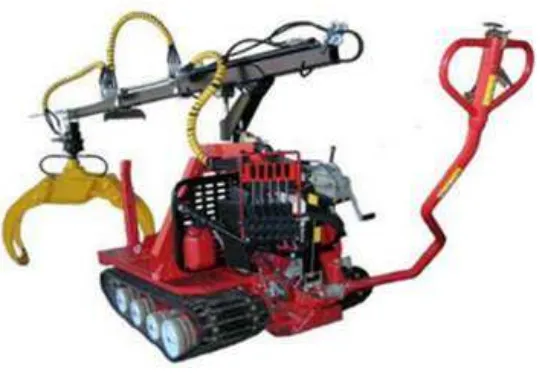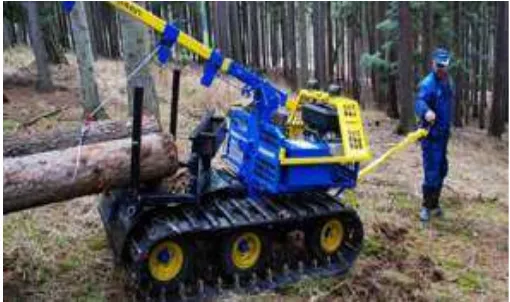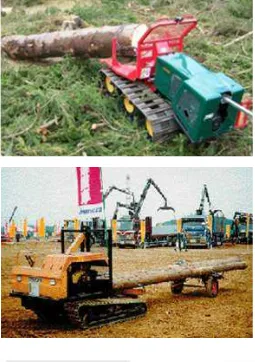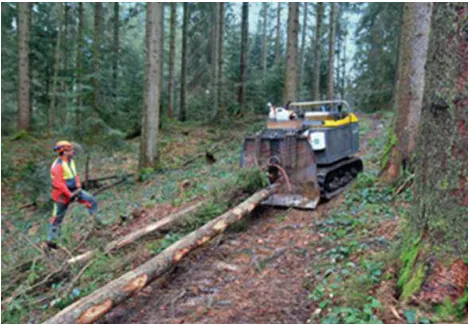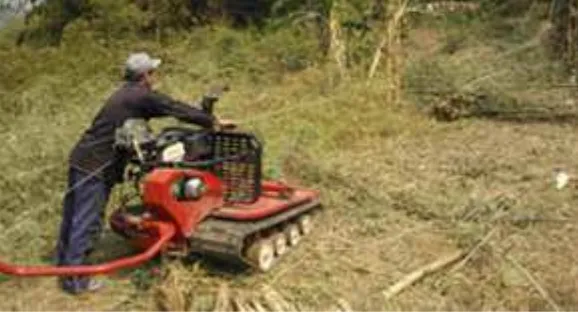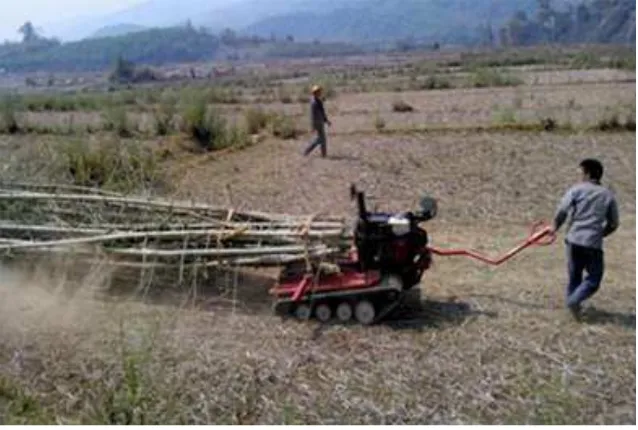2
Rubber-tracked mini-skidders
RECOFTC - The Center for People and Forests
Copyright © RECOFTC December 2015 Bangkok, Thailand
All photos courtesy of RECOFTC except where reference is indicated
Reproduction of this publication for educational or other non-commercial purposes is authorized without prior written permission from the copyright holders provided the source is fully acknowledged. Reproduction of this publication for resale or other commercial purposes is prohibited without written permission of the copyright holder.
This publication has been generously funded by the Ministry for Foreign Afairs of Finland. The views expressed in this publication are those of the authors and do not necessarily relect the views of RECOFTC and our donor organizations.
Table of contents
1. Introduction
1
2. Variants of rubber-tracked crawlers
3
2.1 Myrebak oxen 3
2.2 Kapsen iron horse 3
2.3 Blatna forest horse mk 18 4
3. Related machinery
5
3.1 Rubber-tracked mini-crawlers manufactured locally from rice-harvesting machines 5
4. Productivity and eficiency in timber extraction
7
4.1 Nordjell (1994) 7
4.2 UK forestry commission (2001) 7
4.3 UK forestry commission (1996) 7
4.4 Gallis (2004) 8
4.5 Halbrook (2005) 8
5.
Case study: productivity and eficiency in mini-skidder extraction of bamboo
11
5.1 Felling and skidding with iron horse winch) 11
5.2 Forwarding with iron horse mini-skidder 12
5.3 Forwarding with locally manufactured miniskidder 13
6.
Conclusions 15
References
16
Annex
17
1. Machine cost calculation template 17
Figures
Figure 1. A 9 hp Iron Horse with hydraulic winch, sidewise loading boom and log trailer. 1
Figure 2. 9 hp Iron Horse with telescopic crane (2-m reach) 1
Figure 3. The Myreback Gustafsson-Oxen mini skidder with loading boom and log trailer
www.myreback.com 3
Figure 4. The Kapsen Iron Horse (www.lesni-technika.cz / [email protected]) 3
Figure 5. Blatna Forest Horse MK 18 (from www.engineeringblatna). 4
Figure 6. Hitachi CG 8 7hp 800 kg load capacity Irish R pound 9500 4
Figure 7. Blatna Forest Horse MK 18 (from www.engineeringblatna). 5
Figure 8. The Yanmar 9HP rice thresher before conversion, note the white handle for
forward movement of the machine 6
Figure 9. Kubota Rice harvester (3 cylinder diesel 18 hp) rubber-tracked base
(www.plunkettorchards.com.au). 6
Figure 10. Hitachi CG 8 mini-dumper 6
Figure 11. Honda TD 500 (650) mini-dumper 6
Figure 12. Yanmar bamboo crawler with engine in reverse position and clamping
device for bamboo poles 6
Figure 13. Iron Horse power winch used to extract bundles of entangled bamboo. 11
Figure 14. Forwarding bamboo culms with branches using an Iron Horse 12
Figure 16. Forwarding delimbed bamboo culms by local mini-skidder 13
Tables
Table 1. Output of skidding (winching to machine) and forwarding to roadside 7 Table 2. Productivity data for Myre-back Oxen in one-man forwarding operations 8
Table 3. Productivity during the iron horse bamboo skidding trial 12
Table 4. Breakdown of time components in the iron horse bamboo skidding cycle 12 Table 5. Iron horse productivity and average load and cycle times with
diferent culm categories 13
Table 6. Breakdown of time components in forwarding of bamboo using an Iron
Horse at distances over 350 m 13
Table 7. Productivity of local mini-skidder, average load and cycle times with
varying culm categories 14
1. Introduction
The Jonsereds Iron Horse (Swedish Järn Hästen) was the irst commercially available rubber-tracked mini-skidder (crawler) to appear in Scandinavian forest operations in the early 1980s. It was developed from smaller all-terrain crawlers, originally designed for use in hunting to transport moose and other large game over long distances. The irst model was equipped with a 3.7 kw Honda engine. Current models manufactured by Lennartsfors are equipped with 4.0 kW, 6.6 kW and 10 kW engines. Also available are a wide range of accessories, including manual or hydraulic winches with 1 000 kilogram (kg) pulling capacities and even a telescopic loading crane with a 200 centimeter (cm) reach for the nine and 13 hp models. Depending on their accessories, the cost of the iron horse ranges from US$ 14 000 (9 hp) to US$ 20 000 (13 hp). Smaller
models are not recommended for forestry operations due to their limited winching and pulling power.
Load capacity of the iron horse reaches at least 1-1.2 meters (m)2 or about 1 000 kilogram (kg) for downhill and lat terrain extraction. Maximum speed of the Iron Horse is 4 to 6 kilometer (km)/hour (hr). Its track system is designed with diferent size drive and support wheels and specially manufactured rubber tracks.
Figure 1. A 9 hp Iron Horse with hydraulic winch, sidewise loading boom and log trailer.
To operate the Iron Horse, one person walks in front of the machine and controls its speed and direction with the steering handle. Moving the steering handle sideways changes the direction of the Iron Horse. A brake and an emergency-stopping tool are also located on the handle.
2. Variants of rubber-tracked crawlers
In addition to the Iron Horse, the last two decades have brought the development of comparable models such as:
2.1 Myrebak oxen
The Myrebak Oxen is equipped with 11 hp (8.1kW), 13 hp (9.6 kW) or 16 hp (11.8 kW) engines with a winch and loading arm. The Myreback Oxen’s track system uses two pairs of three standard, equal-sized rubber tire wheels that are covered
with double rubber belts and connected using U-proile steel bars. Load capacity is 1 000 kg, machine width is 1 115 millimeters (mm) and driving speed, which corresponds to walking speed, is 4-5 km/hr. The ex works price of the machine is around US$ 12 000 not including the accessories.
Figure 3. The Myreback Gustafsson-Oxen mini skidder with loading boom and log trailer www.myreback.com
2.2 Kapsen iron horse
The Kapsen Iron Horse is a 13 hp (10kW) powered rubber-tracked machine developed for the Czech market. Its hydraulic power system allows the gradual control of travelling speed, which reaches up to 6 km/ hr. The Kapsen Iron Horse also has a hydraulic winch and a log-loading boom and can be equipped with a hydraulic clamp bank for smaller-sized materials (e.g. bamboo) and a log trailer. The machine’s loading capacity is 1.5 m3 and its pulling capacity is about 1 000
kg. The width of the machine is 120 cm and the width of its rubber tracks is 40 cm. Its ex
works price is around US$ 15 000. Figure 4. The Kapsen Iron Horse (www.lesni-technika.cz /
4
2.3 Blatna forest horse mk 18
The Blatna Forest Horse was, like the Kapsen Iron Horse, developed for the Czech market. It is equipped with a Kohler Command 18 hp petrol engine. Its loading capacity is 1-1.2 m3 or 800-1 000 kg. Its winch
pulling capacity is 1 500 kg, the highest capacity of all the models discussed thus far. The Forest Horse has a winch with a cable capacity of 45 m if using a 6.3 mm diameter steel cable; the cable volume capacity can be reduced to 35 m if an 8 mm steel cable is used. The winch can be controlled remotely, which is an important safety consideration for log extraction to the point of loading on the mini crawler. The machine’s traveling speed is 4-6 km/hr and its width is 120 cm with 40 cm wide rubber tracks. The
ex works price of the machine is US$ 22 000.
Figure 5. Blatna Forest Horse MK 18 (from www.engineeringblatna).
3. Related machinery
It is worth mentioning that there are currently three related Swiss models of self-propelled winches on the market: 1) Alther Raup trac with a 48-hp Kubota engine and a 4-ton winch (www.martin-alther.ch); 2) Wicki Forst Raupe with a 55-hp Lombardini diesel engine, an Adler 4-ton winch and a rope capacity of 150 m (www.wickiforst.ch); and 3) Aggeler Forstraupe with a 33-hp engine, a 4-ton winch and a rope capacity of 100 m (www. Aggeler.ch). All three machines cost over US$ 30 000.
Figure 7. Alther Raup track rubber tracked forwarding winch (www.martin-alther.ch).
3.1 Rubber-tracked mini-crawlers manufactured locally from
rice-harvesting machines
6
US$ 3 000, where about US$ 1 200-1 500 is spent on purchasing used rice thresher machines, while US$ 600 to US$ 800 is spent on mechanical conversion work.
Figure 9. Kubota Rice harvester (3 cylinder diesel 18 hp) rubber-tracked base (www.plunkettorchards. com.au).
Figure 8. The Yanmar 9HP rice thresher before conversion, note the white handle for forward movement of the machine
Figure 11. Honda TD 500 (650) mini-dumper Figure 10. Hitachi CG 8 mini-dumper
4. Productivity and eficiency in timber
extraction
4.1 Nordfjell (1994)
Nordjell (1994) carried out a thinning study on lat terrain in Sweden with the Jonsereds Iron Horse in a 26-year-old spruce forest. Extraction distance to strip roads was 80 m for loading onto grapple-loading forwarders. Mean volume for thinned trees was 0.06 m3 with an average load size of 0.68 m3.
Harvesting eiciency was 0.71 /m3/person/hr or 5.7 m3/person/day, based on an eight-hour shift. The
use of the Iron Horse indicated advantages, particularly in pulling down trees that were entangled in neighboring crowns during felling. The performance was similar to motor manual thinning with the manual dragging of logs to strip roads over an average distance of 41 m. The study makes clear that the advantage of the system begins in situations involving large extraction distances where more than 100 m have to be covered.
4.2 UK Forestry commission (2001)
In a study by the UK Forestry Commission (2001), extraction with the Iron Horse was conducted in broadleaf forests (oak/ash/birch) on terrain with a 30 percent slope over extraction distances of about 100 m. Work time included 17 percent for rest and 16 percent for other work. Felling and delimbing was not included in the time study.
Table 1. Output of skidding (winching to machine) and forwarding to roadside
Load size (m3) 0.20 0.30 0.40 0.50 0.60 0.70 0.80
Skidding output (m3/person/hr) 1.00 1.21 1.35 1.39 1.47
Forwarding (good access) (m3/person/hr over 100 m)
1.75 1.86 2.03 2.30
Forwarding (poor access) (m3/person/hr over 100 m)
1.49 1.58 1.68 1.90
4.3 UK Forestry commission (1996)
In another study by the UK Forestry Commission (1996), the Myre-back Oxen mini-skidder was tested
8
Table 2. Productivity data for Myre-back Oxen in one-man forwarding operations
Site I II
Slope Moderately steep Steep
Mean extracted load (m3) 1.43 1.06
Average piece size (m3) 0.027 0.028
Extraction distance (m) 168 55
Output (m3/hr) 1.7 1.35 (manual) - 1.5 (wire loading)
Daily output (m3 /day/person) 13.5 11 - 12
4.4 Gallis (2004)
Gallis (2004) carried out a comparative study between the Jonsereds Iron Horse with a two-man team and another team of two men and a six-pack of horses/mules in the extraction of small timber (fuel wood size 0.01-0.02 m3) on mountainous terrain in Greece. The 20 extraction cycles for the iron horse
resulted in an average distance of 320 m (270-360 m) on sloping terrain (15 percent to 20 percent). The average performance of the team was 29 minutes corresponding to 3.0 m3/hr covering the average
distance. The average output was 1.5 m3/person/hr. The igures presented here are conversions of the
stacked cord cubic meter (1.2 x 1.0 x 1.0 m) used in the study with a factor of 0.6 to arrive at a solid cubic meter. Felling and delimbing were not included in the time study and the study also did not include rest or other time categories. On a daily basis (eight-hr shift), this may correspond to approximately 7 m3/person/day, assuming that at least 30 percent of the time was allocated to rest and other time
categories. Due to the low costs for horse and manual labor, mini-skidder extraction resulted in a cost that was 26 percent higher.
4.5 Halbrook (2005)
In Idaho, United States, Halbrook (2005) studied fuel load reduction using an Iron Horse with a two-man team and compared it with tractor and all-terain vehicle (ATV) extractions. The analysis was divided into felling/delimbing/bucking (Phase 1) and skidding (Phase 2). 45 skidding turns were recorded during this study totaling 130 logs with a total volume of 27 m3. During Phase 1, the mean total cycle time
(including delays) was 8.99 minutes. On average, 3.31 logs were produced ranging 3-8 m in length with an average length of 5.1 m. The average log contained 0.21 m3 with a butt end diameter of 25 cm.
During this study, Phase 1 productivity averaged 15.4 logs (+/- 2 logs) per hour with a total volume of 3.2m3 per hr (+/- 0.42m3). Delays accounted for 43 percent of the total cycle time, of which nine percent
were mechanical, 38 percent operational and 53 percent personal. Clearing trails, slashing brush and cutting small trees (less than 5 cm DBH) accounted for 92 percent of all operational delays. Analysis of the results suggests that piece-volume ratio was the only statistically signiicant predictive variable for Phase 1.
Phase 2 involved forwarding logs to a landing. During this phase, the mean total cycle time (including delays) was 13.68 minutes. On average, 2.89 logs (4.7 m in length) were skidded per cycle. The average load volume was 0.6 m3. Delays made up 28 percent of the total cycle time, which included mechanical
5. Case study: productivity and eficiency in
mini-skidder extraction of bamboo
RECOFTC carried out intensive harvesting trials on bamboo (Dendrocalamus membranaceus, local name Mai Sang) during the dry season of 2013-2014 in Bokeo province, northern Lao PDR (Salakka, 2014). These trials studied extraction costs for bamboo poles – with and without branches – that were transported to roadsides where mobile chipping into biomass chips followed to determine the feasibility of using biomass fuel chips for power generation. In addition to the Jonsereds Iron Horse and the local hand sulky crawler converted from a Yanmar rice harvester, motor winches and tractors were also included in the comparative trials, the irst study of its kind on record.
5.1 Felling and skidding with iron horse winch
During the harvesting trials in Bokeo province, Lao PDR, the Iron Horse was also used for skidding (winching) trials in combination with chainsaw felling in both thinning culms, leaving U-shaped remnant culms, and clear felling of clumps. The Iron Horse winch proved far more powerful in comparison to the hand and portable winches that it was tested against. Moreover, the force required for entangling bamboo clumps was so strong that, despite the heavy weight of the machine, an additional anchoring point was needed to keep the Iron Horse in place. Skidding distances were 15-25 m, depending on winch placement.
The work team consisted of one chainsaw operator for felling and one operator for the mini-crawler. The average cycle time was 37.5 minutes and the average extraction volume was 159 kg (5-10 culms per bundle). Overall productivity reached as high as 0.128 tons/person/hr. Chainsaw productivity increased from 0.665 tons/hr to 1.021 tons/hr when delimbing was omitted. Preparatory work consumed 21.46 percent of the winch operator’s total time. These numbers illuminate how time-consuming this process is and shows that this approach is too ineicient and should not be performed.
12
Noticeable stacking productivity decreased dramatically when delimbing was not performed, due to heavy entangling within the extracted bundle. Stacking required 33.73 percent of the winch operator’s total time and 9.38 percent of the chainsaw operator’s.
Table 3. Productivity during the iron horse bamboo skidding trial
Productivities U-shape Clear cutting
Chainsaw 0.665 1.021 t/h
Winch 1.428 1.526 t/h
Delimbing, chainsaw 0.306 Omitted t/h
Stacking 1.099 0.592 t/h
Table 4. Breakdown of time components in the iron horse bamboo skidding cycle
U-shape Clear cutting
Time components Chainsaw Winch
Preparatory work 6.6 3.4 8.0
Clearing area around the clump 0.3 2.1 0.0
Removing undesired material 8.2 5.6 0.0
Chainsaw cutting 5.0 3.8 0.0
Bundling the culms 2.9 2.1 3.0
Extraction with winch 3.3 2.5 10.6
Delimbing 28.9 0.0 0.0
Stacking 8.1 3.5 12.6
Delays 2.8 2.3 0.8
Waiting - 12.3 2.4
Overall time (minutes) 66.1 37.5 37.5
5.2 Forwarding with iron horse mini-skidder
Iron Horse forwarding pro-ductivity was measured over an extraction distance of 350 m. Results with diferent raw material categories are presented in Table 5.
Table 5: Iron horse productivity and average load and cycle times with diferent culm categories
Productivity, t/h Average load, kg Average cycle time, min
Dead culms 0.472 366 46.6
Below 5 cm delimbed 0.731 556 45.6
Over 5 cm delimbed 0.783 710 54.5
Below 5 cm whole culm 0.463 343 44.5
Over 5 cm whole culm 0.532 549 61.9
Table 6: Breakdown of time components in forwarding of bamboo using an Iron Horse at distances over 350 m
Trip without the load 7.2 7.7 6.5 6.2 5.9
Loading 14.7 13.0 13.9 15.0 21.6
Tie-up the belts 5.7 6.7 6.9 3.9 4.5
Trip with the load 9.0 8.3 10.3 5.7 9.4
Opening the belts 2.4 2.1 3.7 0.9 1.5
Unloading 7.7 7.8 10.7 8.9 19.1
Delays 0.0 0.0 2.5 3.9 0.0
Overall time, min 46.6 45.6 54.5 44.5 61.9
Table 6 shows that loading and unloading consumed 40 minutes of total cycle time (65 percent of total cycle time) due to the heavy weight of culms and the large quantity of entangled branches.
5.3 Forwarding with locally manufactured mini-skidder
The locally manufactured mini-skidder was used in the same way as the Iron Horse. Its forwarding productivity varied from 0.241 tons/hr (dead) to 0.401 tons/hr (whole culm size over 5 cm) while covering
14
Table 7. Productivity of local mini-skidder, average load and cycle times with varying culm categories
Productivity, t/h Average load, kg Average cycle time, min
Dead 0.241 226 56.4
Below 5 cm delimbed 0.362 340 56.4
Over 5 cm delimbed 0.348 437 75.3
Below 5 cm whole culm 0.356 385 65.0
Over 5 cm whole culm 0.401 443 66.3
Table 8. Time elements between diferent elements of forwarding with local mini-skidder
Element Dead < 5 cm
Trip without the load 12.5 12.5 12.5 12.6 12.6
Loading 4.9 7.8 8.2 16.8 11.0
Tie-up the load with belts 4.9 6.7 7.4 12.4 8.5
Trip with the load 15.2 12.4 13.8 10.7 13.6
Opening the belts 1.1 1.9 2.4 5.9 2.8
Unloading 2.9 6.0 8.2 6.6 11.6
Re-loading during the trip 14.9 9.2 22.9 0.0 6.0
Delays 0.0 0.0 0.0 0.0 0.0
Overall time, min 56.4 56.5 75.4 65.0 66.1
6. Conclusions
16
References
UK Forestry Commission 2001, “The Iron Horse,” Outdoor workshop information note, ODW 8.02, UK Forestry Commission, United Kingdom, p. 3.
UK Forestry Commission 2001, “Extraction by the Iron Horse in broadleaved woodland,” Report 1/93, UK Forestry Commission, United Kingdom.
UK Forestry Commission 1996, “Small scale mechanized extraction: Case studies (Oxen),” Report, UK Forestry Commission, United Kingdom, 2/97.
Gallis, Ch 2004, “Comparative cost estimation for forwarding small-sized beech wood with horses and mini-skidder in northern Greece,” Forest Products Journal, Vol. 54, No. 11, pp. 84-90.
Halbrook JM 2005, “Productivity and Cost Analysis of Three Small-Scale Harvest Systems for Fuel Reduction Within the Wildland Urban Intermix of North Central Idaho,” MSc Thesis, College of Graduate Studies, University of Idaho, United States.
Holmsen, S.D. 1988 “Selectively logging Dry-Belt Douglas-Fir with the Iron horse Mini Skidder” Forest Engineering Research Institute of Canada (FERIC), Vancouver Silviculture Field Note - 9, Vancouver, Canada, p. 2.
Lindroos, O 2004, “Minilunnare/miniskotare,” FÖR-programmet Del. 8, Small-scale forestry equipment, http://www-ssko.slu.se/~diwa/FOR.htm.
Mac Donncadha, M 1997, “Japanese forestry and forest harvesting techniques–With emphasis on the potential use of Japanese harvesting techniques on steep and sensitive site in Ireland,” COFORD, Iwate University, Iwate, Japan, p. 21.
Nordjell, T 1992, “Repair and maintenance costs for mini skidders,” Small-scale Forestry, Vol. 2, pp. 15-18. Nordjell, T 1994, “Comparative time study of thinning with mini-forwarder (Jonsereds Iron horse),” Swedish University of Agricultural Sciences, Department of Operational Eiciency, Uppsala, Sweden, Research Note 267, p. 79.
Salakka J 2014, “Identifying appropriate small scale harvesting technologies for commercial sscale bamboo fuel chip production in Lao PDR,” Karelia University Applied Sciences Degree Program in Forestry, Finland, p. 64.
Annex
1: Machine cost calculation template
Manufacturer: ______________________________ Model: ____________________ HP: _________________________ Purchase price:
Total price of transportation to site:
Total:
$ ______________________________
$ ______________________________
$ ______________________________
(P) INITIAL INVESTMENT $_________________
(S) Salvage Value (____% of P) $_________________
(N) Estimated Life: ____ years
(SH) Scheduled operating time: ___ hrs/yr
(U) Utilization: ___ %
(H) Productive time ____ hrs/yr
(AVI) Average value of yearly investment
AVI = [((P-S)(N+1))/2N]+S $_________/yr
I. Fixed cost:
Depreciation= (P-S)/N $_______/yr
Interest (____ %), Insurance (____ %), Taxes (____ %)
Total ____ % x ($____/yr) $_______/yr
(1) Fixed cost per year $_______
(2) Fixed cost per H (1÷H) $_______
II. Operating cost: (based on productive time)
Maintenance and repair (_____% x ((P-S)/(N x H)) $_______
Fuel (____ L x $____/L) $_______
Oil & lubricants $_______
Tires (1.15 x (tire cost)/tire life in hrs.) $_______
(3) Operating cost per H $_______
III. Machine cost per H (without labor) (2+3) $_______
18
2: Suppliers
1. Jonsered power products
S- 433 81 Jonsered
Tel: 031-94 90 00, Fax: 031-94 91 10 www.jonsered.se
2. Myreback maskin
Box 12 S- 667 21 Forshaga
Tel: 054-87 23 10 Fax: 054-87 42 82 [email protected] www.myreback.com
3. Reparoservis (kapsen)
Jakobiho 328
10900 Praha 10-petrovice
[email protected], www. lesni-technika.cz
4. Blatna engineering
Vrbenská 25, CZ 300 01 Blatná Tel: 383 420 450
20
RECOFTC’s mission is to enhance capacities for stronger rights, improved governance and fairer beneits for local people in sustainable forested landscapes in the Asia and the Paciic region.
RECOFTC holds a unique and important place in the world of forestry. It is the only international not-for-proit organization that specializes in capacity development for community forestry. RECOFTC engages in strategic networks and efective partnerships with governments, nongovernmental organizations, civil society, the private sector, local people and research and educational institutes throughout the Asia-Paciic region and beyond. With over 25 years of international experience and a dynamic approach to capacity development – involving research and analysis, demonstration sites and training products – RECOFTC delivers innovative solutions for people and forests.
